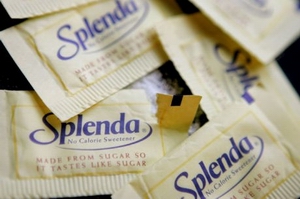 here’s new controversy swirling around that little yellow packet of Splenda many Americans stir into their morning coffee.
here’s new controversy swirling around that little yellow packet of Splenda many Americans stir into their morning coffee.Consumer watchdog group Center for Science in the Public Interest (CSPI) has downgraded sucralose (known by the brand name Splenda) from a “safe” rating to “caution” in its Chemical Cuisine guide after an Italian laboratory found the sweetener caused leukemia in mice.
“Sucralose may prove to be safer than saccharin, aspartame, and acesulfame potassium, but the forthcoming Italian study warrants careful scrutiny before we can be confident that the sweetener is safe for use in food,” said CSPI executive director Michael F. Jacobson in a statement.
Note that the publication of the Italian study is still forthcoming, a point that McNeil Nutritionals, maker of Splenda, cites in its response to the CSPI downgrade:
“The Center for Science in the Public Interest is basing recent comments about sucralose on data from an Italian research lab that has not been published and, to our knowledge, not peer reviewed. Previous research from this lab has been questioned by global food safety authorities, partly because it did not follow accepted standards essential for assessing safety,” says the company in a statement provided to TakePart.
Lisa Lefferts, a senior scientist with CSPI, says it’s true the laboratory does not follow the usual protocols, but in fact, uses a superior protocol that is better able to detect cancer.
“We have the abstract of the study and what the laboratory said about leukemia. We don’t have the full data yet. That’s why we put ‘caution’ instead of ‘avoid.’ When there is evidence that something causes cancer, we take that pretty seriously. [Sucralose] caused cancer in the animals. We thought that we should pass that information on, and couldn’t, in good conscious, say it was safe,” Lefferts says.
Despite concerns about risks posed by artificial sweeteners, CSPI says consumers who drink soda are still better off consuming diet soda than sugar-sweetened, but urges consumers to swtich to water or drinks like seltzer or unsweetened ice tea. The alternative sweetener Stevia also remains on the group’s “safe” list.
If you’re not sure what that “caution” label really means, CSPI defines it this way: a substance that “may pose a risk and needs to be better tested. Try to avoid.” Its “avoid” label, which has not yet been attached to Splenda, is defined as: “unsafe in amounts consumed or is very poorly tested and not worth any risk.”
New York University professor of nutrition, food studies and public health Marion Neslte regularly addresses artificial sweeteners on her widely read Food Politics blog. When asked about the new concerns over Splenda, she tells TakePart, “Splenda is and always will be a non-starter for me. One of my top food rules is never to eat anything artificial. If you eat real food, you don’t have to give a thought to whether Splenda is good, bad or indifferent. It’s simply off the table, where I think it should be.”
Lefferts said a release date for the full study has not yet been announced. In the meantime, the food industry continues to work on a bevy of new sweeteners, including Monatin, which is not yet in use in the U.S.
“Companies are also looking at sweetness enhancers—when added to other natural or artificial sweeteners means you won’t need as much,” says Lefferts.







